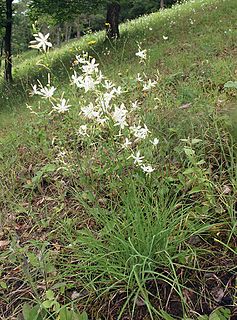
The International Union for Conservation of Nature (IUCN) Red List of Threatened Species, founded in 1964, is the world's most comprehensive inventory of the global conservation status of biological species. It uses a set of criteria to evaluate the extinction risk of thousands of species and subspecies. These criteria are relevant to all species and all regions of the world. With its strong scientific base, the IUCN Red List is recognized as the most authoritative guide to the status of biological diversity. A series of Regional Red Lists are produced by countries or organizations, which assess the risk of extinction to species within a political management unit.

Allium tuberosum is a species of plant native to the Chinese province of Shanxi, and cultivated and naturalized elsewhere in Asia and around the world.

Chlorophytum comosum, usually called spider plant but also known as spider ivy, ribbon plant, and hen and chickens is a species of perennial flowering plant. It is native to tropical and southern Africa, but has become naturalized in other parts of the world, including western Australia. Chlorophytum comosum is easy to grow as a houseplant; variegated forms are the most popular.

Anthericum is a genus of about 65 species, rhizomatous perennial plants in the family Asparagaceae, subfamily Agavoideae. It was formerly placed in its own family, Anthericeae. The species have rhizomatous or tuberous roots, long narrow leaves and branched stems carrying starry white flowers. The members of this genus occur mainly in the tropics and southern Africa and Madagascar, but are also represented in Europe.

Chlorophytum, is a genus of almost 200 species of evergreen perennial flowering plants in the century plant subfamily within the asparagus family. The plants are native to the tropical and subtropical regions of Africa, Australia, and Asia.

Chlorophytum borivilianum is a herb with lanceolate leaves, from tropical wet forests in peninsular India. The Hindi name is safed musli.
A Group is a formal category in the International Code of Nomenclature for Cultivated Plants (ICNCP) used for cultivated plants (cultivars) that share a defined characteristic. It is represented in a botanical name by the symbol Group or Gp. "Group" or "Gp" is always written with a capital G in a botanical name, or epithet. The Group is not italicized in a plant's name. The ICNCP introduced the term and symbol "Group" in 2004, as a replacement for the lengthy and hyphenated "cultivar-group", which had previously been the category's name since 1969. For the old name "cultivar-group", the non-standard abbreviation cv. group or cv. Group is also sometimes encountered. There is a slight difference in meaning, since a cultivar-group was defined to comprise cultivars, whereas a Group may include individual plants.

Allium chinense is an edible species of Allium, native to China, and cultivated in many other countries. Its close relatives include the onion, shallot, leek, chive, and garlic.

The razor-billed curassow is a species of bird in the family Cracidae. It is found throughout a large part of the Amazon Rainforest, though largely restricted to regions south of the Amazon River. Unlike other members of the genus Mitu, its crissum is deep chestnut and the tail-tip is white. The razor-billed curassow was formerly treated as a subspecies of Mitu mitu, but today this scientific name is restricted to the extremely rare Alagoas curassow.

Helicia is a genus of 110 species of trees and shrubs, constituting part of the plant family Proteaceae. They grow naturally in rainforests throughout tropical South and Southeast Asia, including India, Sri Lanka, Indochina, Peninsular Malaysia to New Guinea and as far south as New South Wales.
Microgramma tuberosa is a species of fern in the family Polypodiaceae. It is endemic to Ecuador. Its natural habitat is subtropical or tropical moist lowland forests. It is threatened by habitat loss.
Trigonosciadium is a genus of five species in the Apiaceae. Trigonosciadium brachytaenium is endemic to Iran, whereas T. tuberosum and T. viscidulum grow in Iran, Anatolia and Iraq.
Tillandsia rhomboidea is a species of flowering plant in the Bromeliaceae family. It is native to Colombia, Bolivia, Honduras, Chiapas, Venezuela, Costa Rica, and Ecuador.

Tillandsia reichenbachii is a species of flowering plant in the Bromeliaceae family. This species is native to Bolivia.
The Achanakmar-Amarkantak Biosphere Reserve is a biosphere reserve in India that extends across the states of Madhya Pradesh and Chhattisgarh, covering a total area of 383,551 hectares (3835.51 km2).

Chlorophytum inornatum is a flowering plant species in the genus Chlorophytum. It is the type species of its genus. It is related to the commonly known plant Chlorophytum also referred to as a "spider plant". 3-(4'-Methoxybenzyl)-7,8-methylenedioxy-chroman-4-one, a homoisoflavanone with antimycobacterial activity, can be isolated from C. inornatum.

Wasnal is a village in the Kallar Kahar Tehsil of Chakwal District, in Punjab, Pakistan. It is approximately 27 kilometers away from Kallar Kahar town leading toward Sargodha highway located 6 kilometers away from Munara bypass of main road. It is bordered by Jhamra to east, Nurpur Sethi to southeast, Munara to southwest and rest of border is surrounded by landscapes and beautiful green mountains.

Chlorophytum filipendulum is a species of flowering plant in the Asparagaceae family. It is endemic to a variety of habitats across large areas of Africa.

Protea stokoei is a flowering shrub which belongs to the genus Protea. The plant is endemic to South Africa. It is found in the Kogelberg and Greenland mountains around Elgin.















